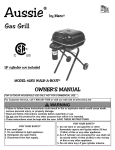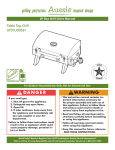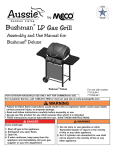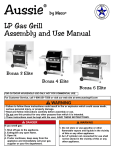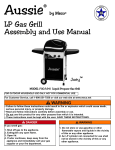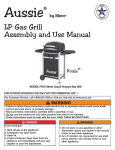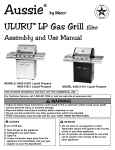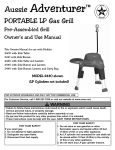Download Aussie 2200 Specifications
Transcript
Aussie ® by Meco® PORTABLE LP Gas Grill Assembly and Use Manual MODEL 2200 FOR OUTDOOR HOUSEHOLD USE ONLY. NOT FOR COMMERCIAL USE. For Customer Service, call 1-800-251-7558 or visit our web site at www.meco.net • Failure to follow these instructions could result in fire or explosion which could cause death, serious personal injury, or property damage. • Read and follow instructions carefully before assembly or use. • Do not use this product for any other purpose than which it is intended. • These instructions must be kept with the user. SAVE THESE INSTRUCTIONS. If you smell gas: 1. 2. 3. 4. Shut off gas to the appliance. Extinguish any open flame. Open lid. If odor continues, keep away from the appliance and immediately call your gas supplier or your fire department. 1. Do not store or use gasoline or other flammable vapors and liquids in the vicinity of this or any other appliance. 2. An LP cylinder not connected for use shall not be stored in the vicinity of this or any other appliance. — NOTICE — MECO CORPORATION STRIVES TO BE A QUALITY SUPPLIER OF CONSUMER PRODUCTS. IF WE OMITTED ANY PARTS NEEDED FOR ASSEMBLY, OR YOU NEED TROUBLESHOOTING INFORMATION, PLEASE CONTACT US USING OUR TOLL FREE NUMBER. THANK YOU FOR PURCHASING A MECO CORPORATION PRODUCT. CONSUMER SERVICE DEPARTMENT 1-(800)-251-7558 MECO CORPORATION 8 am - 6 pm E.S.T Mon. - Fri. www.meco.net 1500 INDUSTRIAL ROAD 1-(423)-639-1171 (TELEPHONE) GREENEVILLE, TN. 37745 USA 1-(423)-639-2570 (FAX) Contents I. Assembly and Set-Up........................................................2 A) Parts Illustrations and Parts List....................................2 B) Assembly.......................................................................4 C) Connecting/Disconnecting The Gas..............................5 1) Using Gas.................................................................6 2) LP Gas Cylinder........................................................6 3) LP Hose and Regulator.............................................6 4) Connecting/Disconnecting 1 lb. LP Cylinder.............6 5) Connecting/Disconnecting 20 lb. LP Cylinder...........7 II. Operating Your Gas Grill....................................................7 A) Before Using Your Grill...................................................7 1) Installation Codes......................................................7 2) Selecting a Location..................................................7 3) Performing a Leak Test..............................................7 4) Lighting the Grill Using the Ignitor.............................8 5) Manual Lighting of the Grill......................................9 B) Using Your Grill ............................................................9 1) Grease Cup..............................................................9 2) Cooking on the Gas Grill.........................................10 3) Check your Flame...................................................11 4) End of Cooking Session.........................................11 C) Care and Maintenance...............................................11 1) Cleaning the Grill....................................................11 2) Transport and Storage...........................................12 III. Troubleshooting................................................................13 V. Important Notice-LP Cylinder with OPD..........................15 VI. Limited Warranty.............................................................16 CARBON MONOXIDE HAZARD This appliance can produce carbon monoxide which has no odor. Using it in an enclosed space can kill you. Never use this appliance in an enclosed space, such as a camper, tent, car or home. ASSEMBLY & SET-UP PREPARATION FOR ASSEMBLY: Remove Grill and all the packaging from carton and place on floor. Make sure there are no loose parts. Note: Before using your grill, read the instructions and your manual. For easier set-up and assembly, follow instructions of each step in the order they are written as you look at the diagrams. If accessories mentioned in certain assembly steps do not come with your model, skip that step and proceed to the next step that applies to your model. To reduce the risk of serious bodily injury or death: ·The use of alcohol, prescription or non-prescription drugs could impair the consumer’s ability to properly assemble or safely operate this appliance. ·Do not connect LP cylinders until assembly is complete. PARTS ILLUSTRATIONS If you need replacement parts, refer to the Parts Illustrations and the Parts List to find the exact parts you need. If you have any questions which require help, contact Customer Service and be sure to mention the model number of your grill. 4 1 9 © MECO CORPORATION® 2004 3 2 5 6 2 8 7 PARTS ILLUSTRATIONS (Cont’d) 13 10 11 14 12 17 18 16 15 19 20 21 22 24 26 23 25 PARTS LIST ITEM 1 2 3 4 5 6 7 8 9 10 11 12 13 14 15 16 17 18 19 20 21 22 23 24 25 26 DESCRIPTION Owners Manual Leg Shelf Handle 6mm x 1 1/8" Threaded Screw Handle Spacer # 6 Lockwasher Stove Grate Smooth Cooking Surface Ribbed Cooking Surface Regulator Hose Assy Control Knob Control Panel 6mm x 3/8" Threaded Screw Grid Insert Guide Grease Cup Chain/Match Holder Control Valve Spring Clip Electrode Spring Clip Wire Electrode Round Burner Assembly (Right Side) Oval Burner Assembly (Left Side) Starter/Manifold Assembly Leg Cap # 10 x 3/8" Self-tapping Screw (Hood/Hinge Attachment) # 10 Lockwasher (Hood/Hinge Attachment) Hood 3 PART # 03.6380.00 03.6360.00 03.6361.00 03.6362.00 03.6363.00 03.6338.00 03.6365.00 03.6366.00 03.6367.00 03.6364.00 03.6368.00 03.6369.00 03.6343.00 03.6370.00 03.6371.00 03.6357.00 03.6372.00 03.6349.00 03.6344.00 03.6373.00 03.6374.00 03.6375.00 03.6376.00 03.6377.00 03.6378.00 03.6379.00 QTY. 1 1 1 2 2 11 1 1 1 1 2 1 10 1 1 1 2 2 2 1 1 1 4 2 2 1 ASSEMBLY TOOLS REQUIRED: Phillips Screwdriver STEP 1. Lay Grill on floor or a level surface. Pull Right Handle Bar all the way out, until it clicks into place. (Fig. 1) (There are three positions). STEP 2. Pull grill off the floor while tilting against your foot or lean it against a wall. Pull the leg shelf away from the Body snap locks at the top. (Fig. 2) Lift Leg Shelf out from the bottom Shelf hooks and set aside. (Fig. 3). STEP 3. Pull downward on the spring loaded Locking Ring of the Right front and rear Legs. (Fig. 4) Swing the legs out and away from the grill until they lock into place. (FIG. 5) STEP 4. Lean Grill on the right legs. (Fig. 6) Lift up other side of the Grill, pull Locking Ring toward end of leg and open the left side legs. (FIG. 7) STEP 5. Pick up the leg shelf and hang the holes in the corners onto the Hooks on the Right Legs. (Fig. 8) Raise left end of Leg Shelf over locking springs until it snaps into place of both legs. (FIG. 9) STEP 6. Squeeze the Strap on top of the Grill to unlock. (Fig.10) Pull out the Left handle bar and fold down the Side Tables. (Fig. 11) STEP 7. Open the Hood. With a Phillips Head Screwdriver, remove the Hood Handle from the inside of the Hood. (Fig. 12) With the same screws, carefully align the Metal Spacers and Handle. (Fig. 13) Be sure the open side of the handle points toward you as you install it. Assemble the Handle on the outside of the Hood. (Fig. 14) Right Handle Bar FIG. 1 FIG. 3 FIG. 2 Pull Leg Locking Ring Down Open Legs Outward FIG. 4 FIG. 6 FIG. 5 4 Bottom Shelf Hook FIG. 7 FIG. 8 Leg Spring Lock FIG. 9 Unlock Strap Open Side Tables FIG. 10 FIG. 11 Remove Hood Handle Open side toward you FIG. 12 FIG. 13 Handle on outside of grill FIG. 14 CONNECTING/DISCONNECTING THE GAS Using Gas · Always use a gas appliance outdoors in an open area with good ventilation to avoid breathing toxic fumes from leaking gas, explosion or fire. As with all conventional fuels, the burning process consumes oxygen and produces toxic gases, including carbon monoxide. In addition, the combustion products of such fuels, including liquefied petroleum (LP), contain chemicals known to the state of California and other authorities to cause cancer, birth defects and other reproductive harm. CARBON MONOXIDE HAZARD · This appliance can produce carbon monoxide which has no odor. Using it in an enclosed space can kill you. · Never use this appliance indoors, on recreational vehicles, or boats. NOTE: Your Gas Grill uses a 1 lb. disposable LP Cylinder but a 20 lb. cylinder and 4 ft adapter hose can be purchased separately. To reduce the risk of serious bodily injury or death: · Use only propane gas in this LP gas grill. · Do not attempt to convert an LP unit to natural gas. · Any use or alteration of this unit not intended could be unsafe and will void your warranty. 5 LP Gas Cylinder The LP gas cylinder, for use with Aussie LP gas grills, must meet the following requirements: 1) Only use cylinders marked “Propane Fuel” 2) 1lb. Disposable Cylinder size should be 4” diameter x 8” tall. 3) 20 lb. Re-fillable Cylinder size should be 12” Diameter x 18” tall. Overfill Protection Device (OPD) safety feature must be noted on the cylinder and must have a collar to protect the LP cylinder valve. 4) Cylinder must be constructed and marked in accordance with Specifications for LP-Gas Cylinders of the U.S. Department of Transportation (DOT) or the National Standard of Canada, CAN\CSA-B339, Cylinders, Spheres and Tubes for Transportation of Dangerous Goods; and Commission, as applicable. (See LP cylinder marking) 5) Cylinder must have a cylinder cap to protect LP cylinder valve when not in use. To reduce the risk of serious bodily injury, fire or death: · Use only 1 lb.. propane cylinders or 20 lb. propane cylinders with proper adapter hose as specified above. Use of other gas cylinders could cause gas leak or fire. · Read and follow all warnings on LP gas cylinder. If you see, smell, or hear the hiss of LP gas escaping from the cylinder: 1. Do not attempt to light appliance. 2. Extinguish any open flame. 3. Disconnect from fuel supply. · Never connect or disconnect LP gas cylinder or fittings while grill is in use or is hot. · When the LP gas cylinder is connected, keep the grill outside in a well-ventilated space. · Do not use an LP gas cylinder if it shows signs of dents, gouges, bulges, fire damage, corrosion, leakage, excessive rust or other forms of visual external damage; it may be hazardous and should be checked by a liquid propane supplier. Do not use an LP cylinder with a damaged valve. · Do not store a spare LP gas cylinder under or near the LP gas grill. · When grill is not in use, turn off all grill control knobs, disconnect 1 lb. cylinder or turn off 20 lb. LP cylinder valve and disconnect LP cylinder. · Never attempt to repair or refill a 1 lb. LP cylinder. Always replace empty or bad cylinder to reduce risk of a hazard or explosion. · Never fill a 20 lb. LP gas cylinder more than 80% of cylinder volume. (20 lb. maximum) Do not ask the propane supplier to over-fill the cylinder. · If you obtain LP gas through a cylinder exchange dealer, make sure you get a safe and adequate O.P.D. cylinder. (See page 15) Use only a licensed LP gas cylinder dealer. LP Hose and Regulator To reduce the risk of serious bodily injury or death: · Clean and inspect the gas hose/regulator before each use of the outdoor cooking gas appliance. The gas hose/regulator must be replaced prior to being used, if there is evidence of excessive abrasion or wear, or if the hose is cut or leaks. · Use only the gas hose/regulator assembly that has been supplied with this gas grill. Do not use hose/regulator from another manufacturer. · Always check for gas leaks when you connect and disconnect the hose/regulator to the LP gas cylinder, especially after a period of storage (for example, over winter). · Make sure there are no sharp bends in the hose. · Make sure hose/regulator does not contact any heated surfaces. If the hose/regulator assembly is not working properly and you need a replacement, contact the manufacturer (1-800-251-7558). Be sure to specify your grill model. Connecting/Disconnecting 1 lb. LP Cylinder STEP 1. Turn the Grill Control Knobs to the “OFF” position. (FIG. 15A) STEP 2. Remove the protective cap from the cylinder gas nozzle. Keep it for re-capping. STEP 3. Grasp the Regulator with one hand. Hold the LP cylinder upright with other hand, push the LP Cylinder nozzle into regulator nipple and turn counterclockwise. (FIG. 15B) Do not turn Cylinder upside down. Make sure the connection does not cross thread. STEP 4. Hand tighten to a snug connection. Do not use tools. To Disconnect the cylinder: STEP 1. Turn the Grill Control Knobs to the “OFF” position. STEP 2. Grasp the Regulator with one hand. Hold the LP cylinder upright with other hand, and turn clockwise. STEP 3. Re-cap the cylinder. FIG. 15A 6 FIG. 15B · If an external electrical source is utilized, the outdoor cooking appliance, when installed, must be electrically grounded in accordance with local codes or, in the absence of local codes, with the National Electrical Code, ANSI/NFPA 70, or the Canadian Electrical Code CSA C22.1. · Keep any electrical supply cord away from any heated surfaces. Connecting/Disconnecting 20 lb. LP Cylinder STEP 1. Turn the Grill Control Knobs to the “OFF” position. (FIG. 15A) STEP 2. Remove the protective cap from the cylinder gas nozzle. Keep it for re-capping. STEP 3. Hook the 20 lb. Cylinder upright to the hanger on the right side. Connect end of hose to Cylinder valve by turning counter-clockwise and hand tighten. (FIG.16A) Selecting a Location STEP 4. Run the other end of the hose under the Leg shelf behind the leg. Grasp and hold the regulator with one hand. Push the hose end into the regulator nipple and turn the knurled knob clockwise. (FIG. 16B) Make sure the connection does not cross thread. Hand tighten to a snug connection. Do not use tools. To reduce the risk of serious bodily injury or death: · This outdoor cooking appliance shall be used only outdoors and shall not be used in a building, garage, or any other enclosed area. Locate outdoor cooking appliance in an area with good ventilation on a level stable surface clear of combustible and flammable material. · Maintain minimum clearances of 36” from back and sides of grill to any combustible construction. · Do not locate this appliance under overhead unprotected combustible construction. · This outdoor cooking appliance is not intended to be used in or on boats or installed in or on recreational vehicles. · Do not use gas grill as a space heater. To Disconnect the cylinder: STEP 1. Turn the Grill Control Knobs to the “OFF” position. STEP 2. Disconnect end of hose to Cylinder valve by turning clockwise. STEP 3. Re-cap the cylinder. LP Cylinder Hanger Performing a Leak Test FIG. 16A To reduce the risk of serious bodily injury or death: · Perform a leak test before each use and each time a gas connection or disconnection is done . · Perform a leak test in a well ventilated area. · Never use an open flame to test for gas leaks. · Never smoke near the grill during a leak test. · Do not perform a leak test on a grill while it is hot or in use. · Do not use the gas grill if you detect a gas leak that cannot be corrected by using the leak test procedures. FIG. 16B How to perform a leak test: See leak test diagrams next page.) OPERATING YOUR GAS GRILL Supplies Needed for a Leak Test: Clean paint brush, water, and dishwashing liquid. BEFORE USING YOUR LP GAS GRILL 1) 2) 3) 4) Mix 1-cup of water with one cup of dishwashing liquid. Make sure all Control Knobs are in the “Off” position. Remove the two Cooking Surfaces. Pull the Control Knobs off the valve stems. Remove the 5-screws securing the Grid Insert Guide, Control Panel and Chain and Match Holder. Lay parts aside. (See FIG. 23A page 12 ) 5) If LP Cylinders are not already connected, attach them according to above instructions for Attaching LP Gas Cylinder to Regulator. Installation Codes To reduce the risk of serious bodily injury or death: · This installation must conform with local codes or, in the absence of local codes, with either the National Fuel Gas Code, ANSI Z223.1/NFPA 54 Natural Gas and Propane Installation Code, CSA B149.1, or Propane Storage and Handling Code, B149.2 or the Standard for Recreational Vehicles, ANSI A 119.2/NFPA 1192 and CSA Z240 RV Series, Recreational Vehicle Code, as applicable 7 6) (For 1lb. Disposable Cylinders)-Check for leaks by brushing the soap solution around the connections between the gas cylinder and the regulator (FIG. 17A), the hose connection to the control valve (FIG. 17B), and the Control valve nozzle. (FIG. 17C) Make sure you generously brush the locations with the soap solution, completely surrounding the connections and fittings. Leak Test at Control Valve Nozzle (For 20 lb. LP Cylinders)-Open the cylinder valve by turning the LP gas cylinder handle counter-clock wise. Check for leaks by brushing the soap solution around the connection between the gas regulator and hose (FIG. 18A) and the hose connection to the LP cylinder valve (FIG. 18B) 7) If “growing” bubbles appear on any of the connection points, then you have detected a gas leak. Immediately disconnect the LP cylinder from the regulator. A) If a leak appears at the connection of the 1 lb. cylinder/regulator, unscrew the cylinder and retighten by hand. Do not use tools.) Repeat Leak Test. B) If a leak appears at the hose/control valve, or nozzle connection, tighten the connection with a wrench. C) If a leak appears at either end of the 20 lb. cylinder/hose or hose/regulator connection, unscrew the hose and retighten by hand. D) If a leak appears around the 20 lb. LP cylinder valve or any other connection that can not be stopped, disconnect the LP Cylinder. Do not use the grill. Call Customer Service at 1-800-251-7558. 8) If no leaks appear, re-assemble the Grid Insert Guide, Control Panel, Chain and Match Holder and Control Knobs. (See How to Clean the Burners) FIG. 17C Leak Test at Hose/Regulator Connection FIG. 18A 20 lb. Cylinder valve hose connection FIG. 18B Lighting the Grill Using the Ignitor Leak Test at Regulator/Gas Cylinder Connections FIG. 17A FIG. 17B Leak Test Hose Fittings and Control Valve Connections To reduce the risk of serious bodily injury or death: · Open Hood before lighting the grill to prevent an explosion from gas build-up. · During failed lighting attempts, or if the burner goes out during operation, turn control knobs “Off” to dissipate any accumulation of gas. Wait five minutes before repeating lighting procedure. How to light your LP gas grill using the ignitor 1) Open the Hood. Make sure LP Cylinder is connected and Control Knobs are “Off”. 2) If using a 20 lb. LP Cylinder instead of 1 lb. LP Cylinder, open the LP gas cylinder valve by turning the valve handle counter-clockwise until it stops. (FIG. 19A) 3) From the “OFF” position, push in and turn the Control Knob counterclockwise to “I” until you feel resistance. (FIG. 19B) 4) Pause 4 seconds, then push in and turn the Control Knob until a click is heard and the burner is lit. Check through the grill body opening and the Cooking Surface to see if burner is lit. (FIG. 19C) 5) Repeat Step 3 until burner is lit. 8 4) Match light the burner with the supplied match holder and a match near the burner. (FIG. 20B & FIG. 20C) 5) If burner does not light, turn Control Knob to “OFF”. Close the valve on the 20 lb. LP gas cylinder. Remove the Cooking Surfaces to dissipate the gas. Wait five minutes then repeat Steps 2 and 3. 6) If burner still fails to light, wait five minutes and refer to the Troubleshooting section. 7) After ignition, preheat the Grill and Cooking Surface by turning the Control Knob to “High” for about 8 minutes. 6) If burner does not light or ignitor does not work, turn Control Knob to “OFF”. Close the valve on the 20 lb. LP gas cylinder. Remove the Cooking Surfaces to dissipate the gas. Wait five minutes, then repeat Steps 2 thru 4. 7) If burner still fails to light, repeat step 5, wait five minutes and refer to the Troubleshooting page. If it fails to light, the burner can be lit manually, see Manual Lighting the Grill. 8) After ignition, preheat the Grill and Cooling Surface by turning the Control Knob to “High” for about 8 minutes. 2) Turn 20 lb. LP Cylinder handle counter-clockwise “ON”. 2) Push in Control Knob; turn counterclockwise to the “H” position. FIG. 19A FIG. 20A 3) Match light the burner through the opening between Grill Body and the Cooking Surface. 3) Push in Control Knob; turn counterclockwise to the “I” position until you feel resistance. Manual Lighting proximity with Cooking Surfaces removed. FIG. 19B FIG. 20B 4) Check through the opening between grill body and the Cooking Surface to see if the burner is lit. FIG. 20C USING YOUR GRILL Grease Cup FIG. 19C To reduce the risk of a fire in the grease cup or bowl: · Never use the LP gas grill without the Grease Cup in place. · Always use a clean and empty Grease Cup before cooking. · Allow grill and grease in grease cup to cool before emptying grease cup. Empty the grease cup after each cooking session so grease does not accumulate. Manual Lighting the Grill To reduce the risk of serious bodily injury or death: · Open Hood before lighting the grill to prevent an explosion from gas build-up. · When manual lighting with a match, Keep your face away from the opening. · During failed lighting attempts, or if the burner goes out during operation, turn control knobs “Off” to dissipate any accumulation of gas. Wait five minutes before repeating lighting procedure. Use Clean and Empty Grease Cup before each grill session. How to manually light your LP gas grill 1) Open the Hood. Make sure LP Cylinder is connected and Control Knobs are “Off”. 2) If using a 20 lb. LP Cylinder instead of 1 lb. LP Cylinder, open the LP Cylinder valve by turning the valve handle counter-clockwise until it stops. (SEE FIG. 19A) 3) From the “OFF” position, push in and turn the Control Knob counterclockwise to “H”. (FIG. 21A) FIG. 21 Install and remove grease cup with steady pressure to snap into grill body. To avoid spillage, do not jerk grease cup with grease in the cup. 9 Cooking on the Gas Grill To reduce the risk of serious bodily injury or death: · Never use charcoal in your gas grill. Keep gas grill clear and free from combustible materials, gasoline and other flammable vapors and liquids. · Keep any electrical supply cord and fuel supply hose away from any heated surfaces. · Make sure there are no gas leaks or obstructions to the flow of combustion and ventilation air before each use. · Keep the ventilation openings of the LP cylinder enclosure free and clear from debris. · To prevent an explosion from gas build-up, always open the hood before lighting the LP gas grill. · Do not attempt to extinguish a grease fire with water or other liquids. Have an BC fire extinguisher accessible. Do not douse or spray the grill or cooking surfaces with water when hot. Burns from grease or the water splatters could occur. · If your gas grill catches on fire: - If the fire is in the grill portion and you can safely reach the control knobs on the control panel, then turn them to the off position. - If the fire is in one of the hoses, and you can safely reach the LP cylinder valve, then shut the valve off. - If the fire involves the cylinder, leave it alone, evacuate the area and call the fire department. - If there is any type of fire that threatens either personal safety or endangers property, call the fire department. · If you notice grease or other hot material dripping from the grill onto the cylinder, or the valve, hose and regulator, turn off the gas supply immediately. After the grill has cooled, determine the cause and correct it. After cleaning the cylinder, valve, and hose and regulator, perform a leak test before continuing use. (See Performing a Leak Test.) · Do not operate a gas grill if you have knowledge of or suspect a gas leak. · Do not wear loose clothing (example: hanging shirt tails, clothing with frills, etc.) around a gas grill while in use or hot. · Do not lean your body over the gas grill when lighting it or while it is in use or hot. · Do not touch hot surfaces. Use heat resistant gloves, long-handled tongs, or cooking mitts at all times since the grill will become very hot. Open the hood carefully when cooking to avoid burns from the hot air and steam trapped inside. · Do not allow children to operate or play near a gas grill. Keep animals and bystanders out of the grill area. Do not leave grill unattended. · Do not move an LP gas grill when in use or hot. · When grill is not in use, turn off all grill control knobs, LP cylinder valve and disconnect the LP cylinder. 10 · Do not pre-heat over 10 min. or the cooking surface coatings may be destroyed. · Do not leave any utensils on the Cooking Surface while it is hot. 1) Wash the Cooking Surfaces with a mixture of hot water and dish detergent. Do not use an abrasive scrubber. This product is non-stick coated and harsh cleaners will ruin the finish. 2) Place the Ribbed Cooking Surface in the Grill to the left with grease drain over the grease cup. Place the Smooth Cooking surface to the right and hook it over the Ribbed Surface. (FIG. 22A) 3) If you wish to use pans or cookware, simply remove the Smooth Cooking Surface and place the Stove Grate over the Round Burner. (FIG. 22B) Be sure and do this before you heat the rest of the grill. Grease Drain Smooth Surface Hooks over Ribbed Surface FIG. 22A Stove Grate FIG. 22B 4) Light the Burner, turn the Control Knob from “High” to “Low” while checking through the opening between the Grill Body and the Cooking Surface to see if it is lit. (See FIG. 19C) and Check Your Flame (FIG. 22C). 5) To preheat: With the Grill Hood closed, preheat on high for about 8 minutes. During the first use, you may notice a slight odor caused by the curing oil on paint or parts. 6) After 8 minutes of preheating, carefully place food on the Cooking Surface. Cook until done, turning food at least once halfway through the cooking time for most foods. Adjust flame as needed with the Control Knobs. 7) When cooking, remove food with long-handled heat resistant, plastic or wooden utensils. Never use metal tongs, forks or knives that can scratch, cut or damage the coating of the Cooking Surfaces. CARE AND MAINTENANCE Check Your Flame To reduce the risk of a cut injury: · Be careful or wear protective gloves when cleaning grill parts that have sharp edges. Your burners have been preset by the manufacturer for optimal flame performance. A primary blue flame, possibly with a small yellow tip, is the result of optimum air and gas mixture. (FIG. 22C) Cleaning the Grill Yellow Tip FIG. 22C Primarily Blue Flame Check the flame before each cooking session and throughout the grilling season. Also check especially after long periods of storing the grill. If the flame is significantly yellow in color, the appropriate amount of LP gas in the air/LP gas mixture is not correct. This could be due to a blocked burner from grease drippings or from insects building a nest inside the burner or burner opening. (See How to Clean the Burners.) End of Cooking Session To reduce the risk of serious bodily injury, fire or death: · Always turn “OFF” the Control Knobs when not in use. Allow grill and grease in Grease cup to completely cool before emptying, handling parts, cleaning, moving or storage. · Empty the Grease Cup after each cooking session so excessive grease does not accumulate. After each cooking: 1) Turn the Control Knobs clockwise to the “OFF” position. 2) Turn off the LP cylinder valve clockwise on a 20 lb. cylinder. 3) Wait until the grill is cool before cleaning the grill or closing the Hood. 4) After the grill is cool, disconnect the 1lb. LP cylinder or the 20 lb. cylinder hose from the Regulator. Replace the protective cap and store LP cylinder in a safe place. (See Transport and Storage ) 5) Empty Grease cup, clean grill and store safely until next cooking session. (See Cleaning the Grill and Transport and Storage ) To avoid damage to any of the grill parts: · Do not clean any grill part in a self-cleaning oven. The extreme heat will damage the finish. · Do not put parts in dishwasher. · Do not immerse the Burner in water. Make sure any water is removed from the Burner. · Never use oven cleaner, steel wool or other abrasive cleaning product on the painted parts or the Cooking Surfaces. These will cause damage to the finish or parts. Regularly clean your LP gas grill between use and after extended storage. 1) Grease cup and Cooking Surfaces-After grill has cooled, empty and clean the Grease Cup. Wipe the Cooking Surface with a paper towel or sponge. After completely cooled, wash with a mixture of dish detergent and hot water, or baking soda. 2) Grill Bowl and Hood-Remove excess grease and/or fat from the grill Bowl with a soft plastic or wooden scraper. Rinse and dry thoroughly. If necessary, use a nylon bristle brush to loosen hardened food particles. Use a damp cloth to clean inside the Grill Bowl and Hood. Wash the other exterior parts with a soft sponge and warm soapy water. Non-abrasive cleaners may be used. 3) Burners-Remove and clean annually, or whenever heavy build-up is found, to ensure that there are no signs of blockage (debris, insects) in either the burner portholes, the primary air inlet, or the neck of the burners. (See How to Clean the Burners below.) 4) After cleaning, replace the burners and all the cleaned parts. To reduce the risk of a fire beneath the grill: · Inspect and clean burner/venturi tubes for insects and insect nests. A clogged tube can cause a fire beneath the grill. · Be sure burners and other cleaned parts are re-installed properly before using grill. How to Clean the Burners: Tools required: Phillips Screwdriver, Pliers 1) Make sure the Grill Control Knobs are turned to the “OFF” position, and the grill has completely cooled. 2) Disconnect the LP cylinder. 3) Remove Grease Cup, Cooking Surfaces and Leg Shelf. 11 4) Pull the Control Knobs off the valve stems. Remove the 5-screws, Grid Insert Guide, Control Panel and the Chain/Match Holder. (FIG. 23A) 5) Remove 2-Control Valve Spring Clips with screwdriver. (FIG. 23B) 6) Remove Electrode Spring Clip by holding end of clip with pliers and pushing down away from the notch in burner bracket. (FIG. 23C) Hold spring with fingers so clip does not flip away. 7) Lay grill on the back side. Remove 5-screws holding the Burner Brackets to underside of Bowl. (FIG. 23D) 8) Remove both Burner Assemblies from the grill. 9) Use a pipe cleaner to clear obstructions from the Burner holes and inlet hole. (FIG. 23E & FIG. 23F) Verify that there are no insects or insect nests blocking the inlet hole. Normal wear and corrosion may enlarge some holes, however, if large cracks or holes are found the Burners should be replaced. 10) After cleaning, re-assemble Burner Assemblies and other parts in reverse order of previous Steps 2-9 disassembly. Note: When refitting the Burners, be sure the tubes are positioned correctly with the valves. 11) Check burner operation after reassembly or cleaning. FIG. 23D 7) Remove 5-Screws from Burner Brackets under Grill bottom. Oval Burner FIG. 23E 9) Use a pipe cleaner to clear obstructions from all burner holes and the Inlet hole. A brass wire brush can be used on the burner surfaces to remove corrosion. 5-Screws Securing Control Panel Grid Insert Guide Round Burner Chain/Match Holder Control Panel FIG. 23F FIG. 23A Transport and Storage 5) Control Valve Spring Clip To reduce the risk of fire, serious bodily injury or death: · Always turn off the Control Knobs when not in use. Allow grill to cool before transporting or storing. · Store your LP gas grill in a cool dry place. · Do not store an LP gas cylinder in a space greater than 125 degrees Fahrenheit. Do not store an LP gas cylinder in a building, garage or any enclosed area. · Do not store an LP gas cylinder indoors (empty or filled). Disconnect the gas cylinder from the gas grill and store it outdoors away from any sources of heat or ignition and out of the reach of children. The gas grill may then be stored indoors. · To prevent fire or explosion, do not leave an LP gas cylinder inside a vehicle that can become overheated by the sun. · Even though your LP gas cylinder may appear to be empty, gas may still be present and the cylinder should be transported and stored accordingly. · Do not store a spare LP gas cylinder under or near the LP gas grill. FIG. 23B 6) Electrode Spring Clip FIG. 23C 12 1) Disconnect the LP gas cylinder from the gas grill. (See page 6). Store LP cylinder outside, in a dry, well-ventilated area, away from sources of heat or ignition. 2) Wrap the Burners with aluminum foil to prevent insects from entering the burner holes. 3) Wipe the cooking surfaces with a light coat of cooking oil and wrap in aluminum foil and place inside the Hood or store inside your dwelling. 4) Place a grill cover over the grill and store it outdoors if possible. It may be stored indoors only if the LP cylinder is disconnected from the gas grill. 5) Before next use, remove aluminum foil and wash the Cooking surfaces. 6) Before using the grill after periods of storage or non-use (i.e. over winter), check your LP gas grill for gas leaks, deterioration, proper assembly, and burner obstructions. 7) Periodically check and tighten all nuts, bolts, and screws. 4) Swing the Gas Regulator up into its storage position behind the front panel of the Grill and clip it into place. (FIG. 24A) 5) Fold Legs to locked position under Grill. 6) Store Leg Shelf back in the bottom of the grill and snap into place. 7) Store Leg Shelf back in the bottom of the grill and snap into place. 8) Grasp the Right side Handle Bar; lift Grill on wheels and roll the grill away to storage area. (FIG. 24B) DO NOT ATTEMPT TO CARRY THE GRILL BY GRASPING THE HOOD HANDLE. Store Gas Regulator & Hose To reduce risk of any bodily injury: · Always Lock the Grill Hood with the Strap Lock before transporting and storing this Grill. · Always transport the grill on the wheels and pull with the slide bar. Do not attempt to carry the the grill by grasping the Hood handle. The strap lock will not support the weight. · Be careful when towing your grill so it does not roll up against you. Storage Clip Fig. 24A Use Slide Handle Bar for Towing Tow-away on Wheels For Convenient Storage Your Gas Grill comes with convenient wheels and a slide out handle for roll-away transport. After the Grill has completely cooled, cylinder is disconnected and the Grill has been cleaned: 1) Fold and strap the Grill side tables over the closed Hood. 2) Slide the Left Handle Bar back under the grill. 3) Remove the leg shelf. Release the locking springs and lower the left end of the Leg Shelf. Lift the other end off the mounting Hooks on the right legs. Fig. 24B TROUBLESHOOTING Problem Possible Cause Solution Burner will not light using the ignitor Not pausing long enough before clicking the Ignitor When lighting the Burner, push in and turn the Control Knob counterclockwise to “I” when you feel resistance. Pause 4 seconds, then push in and turn the Control Knob until a click is heard. No spark The spacing between electrode and Burner ports should be approximately 3/16”. Make sure wire connections are secure and burner is attached securely to brackets. LP gas cylinder is empty Dispose of empty cylinder and replace with a full one. 13 TROUBLESHOOTING (cont’d) Problem Burner will not light using a match Possible Cause Solution Excess flow valve tripped in Regulator Turn Control Knob to “OFF” position. Wait five minutes. Relight LP gas grill. If flame remains to be low, turn off gas. Disconnect the Lp gas cylinder from the Regulator. Reconnect the LP gas cylinder to the Regulator. Perform a leak test. Relight grill. This will reset the excess flow valve. Obstructions in burner Clean burner (See How to Clean the Burners in Care and Maintenance section of this manual). Electrode and burner are wet Dry electrode with clean cloth Wire is loose or disconnect- Reconnect the wire Wire is shorting (sparking between ignitor wire and electrode Replace ignitor wire/electrode assembly (Call the Customer Service Department @ 1-800-251-7558) Burner not assembled correctly See burner re-assembly in How to Clean the Burners. LP gas cylinder is empty Dispose of empty cylinder and replace with a full one. Excess flow valve tripped in Regulator Turn Control Knob to “OFF” position. Wait five minutes. Relight LP gas grill. If flame remains to be low, turn off gas. Disconnect the Lp gas cylinder from the Regulator. Reconnect the LP gas cylinder to the Regulator. Perform a leak test. Relight grill. This will reset the excess flow valve. Obstructions in burner Clean burner (See How to Clean the Burners in Care and Maintenance section of this manual). High or gusting winds Turn front of grill away from wind or increase flame height. Gas in LP cylinder is low Check LP gas cylinder. Replace if necessary. Grease build up Clean grill Excessive fat in meat Trim fat from meat before grilling Persistent grease fire Grease trapped in Bowl and around burner system Turn Control Knobs “OFF”. Let fire burn out and remove Cooking Surfaces. After the grill cools, clean all parts. Humming or whistling from the regulator Outside temperature, humidity, barometric pressure, and the gas level within the tank may cause the rubber diaphragm inside the regulator to vibrate, making a humming or whistling sound. Although this sound may be alarming, this is NOT dangerous as long as it is not accompanied by the smell of gas. Simply adjust the burner settings and usually the sound will subside. If the humming sound persists, a change in atmospheric conditions will eventually stop the vibration. Should you smell gas, do not use the grill and call Customer Service at 1-800-251-7558 Flames blow out Flare up Low flame or low heat Gas in LP cylinder is low Check LP gas cylinder. Replace if necessary. If your problem is not resolved from the information provided above, please call Customer Service at 1-800-251-7558. 14 IMPORTANT NOTICE (Only if using a 20 lb. LP Cylinder and an adapter hose) The Gas Grill is can be setup to operate with a LP Gas Cylinder equipped with an OPD (Overfilling Prevention Device). This is a secondary device to prevent the overfilling of your LP Gas cylinder. The proper methods for the filling of your LP Gas cylinder are by weight or volume, as described in NFPA 58. Please make sure your filling station fills your LP Gas cylinder by weight or volume. Ask your filling station to read purging and filling instructions on the LP cylinder before attempting to fill. Raises up while filling then stops when full. Do not exchange the LP Gas cylinder unless the exchange LP cylinder is equipped with an OPD. Otherwise you will lose the OPD (Overfill Prevention Device) feature. If there is not an LP cylinder available for exchange equipped with an OPD, we recommend that you have your cylinder filled at an authorized LP gas dealer by a qualified attendant. 15 MECO CORPORATION LIMITED WARRANTY This product is warranted to the original consumer purchaser against defects in material and workmanship under normal outdoor household use and correct assembly (if assembled by the consumer-purchaser). The Grill and its components are warranted for a period of one (1) year from the date of purchase. Meco Corporation DOES NOT warrant in any way the propane cylinder (see label on cylinder for cylinder manufacturer’s warranty.) The LP cylinder manufacturer is responsible for the materials, workmanship and performance of the cylinder. If the cylinder has a defect, malfunctions, or you have a question regarding the cylinder, call the cylinder manufacturer’s customer service center. The phone number is on the cylinder. If the cylinder manufacturer has not resolved the issue to your satisfaction, then call Meco Corporation at the customer service number listed below. Meco Corporation may require reasonable proof of purchase and we suggest you keep your receipt. Damages caused by commercial or institutional use, accidental or intentional damage, repairs made or attempted by unauthorized persons, or misuse are not covered by this warranty. If defective, the part or product will be repaired or replaced at the option of Meco Corporation without charge. This warranty does not include the cost of any inconvenience or property damage due to failure of the product and does not cover damage due to misuse, abuse, accident, damage arising out of transportation of the product, damage incurred through commercial use, or failure to perform normal and routine maintenance. LIABILITY FOR CONSEQUENTIAL PROPERTY OR COMMERCIAL DAMAGES ARE EXPRESSLY EXCLUDED BY THIS WARRANTY. ANY APPLICABLE IMPLIED WARRANTIES OF MERCHANTABILITY AND FITNESS ARE LIMITED IN DURATION TO THE PERIOD COVERAGE OF THIS EXPRESS WRITTEN LIMITED WARRANTY. Some states do not allow limitation on how long an implied warranty lasts, so this limitation may not apply to you. Deterioration or damage due to severe weather conditions such as hail, hurricanes, earthquakes or tornados, discoloration due to exposure to chemicals either directly or in the atmosphere, is not covered by this limited warranty. No returns will be accepted without prior authorization from Meco Corporation. Authorization for return may be obtained by calling 1-800-251-7558. Handling and transportation costs for returning the product are not covered by this warranty and will be paid for by the purchaser. Please send your correspondence to: Meco Corporation 1500 Industrial Road Greeneville, TN 37745 For reference and correspondence, Serial No.____________________ record your Serial number here. Pease use this number in registering (See nameplate on side of grill.) your warranty and any correspondence with Meco Corporation. 16 P/N 03.6380.00 REV. 11/06
















